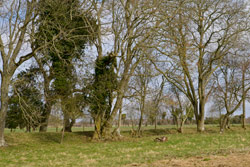Ancient boundaries and Land Ownership
 The AONB is historically a marginal area on the boundary between peoples, places and identities. This has had an important impact on its historic character.
The AONB is historically a marginal area on the boundary between peoples, places and identities. This has had an important impact on its historic character.
The ancient county boundaries of Dorset, Hampshire and Somerset run across the area. These boundaries are associated with 'gates', large trees and coppices, and banks. A network of ancient parish boundaries also sit within this framework, again associated with key ancient trees and in some instances deliberately coinciding with Prehistoric monuments.
The Medieval systems of land division, the system of Hundreds, has also had a profound impact on the character of the landscape. In the Early Medieval period these were created independent of county or parish boundaries. There boundaries are not legible in the landscape, but they formed the basis on which land was transferred to ecclesiastical magnates such as the Abbeys of Shaftesbury, Winchester and Glastonbury in the Medieval period. They remained in church lands until the Dissolution when the same land parcels were granted to the nobility. This resulted in a great continuity of both land ownership and groupings of holdings in the AONB landscape.
The ecclesiastical Medieval pattern of land ownership is represented by the network of ruined houses and other forms of religious houses. The impact of the direct landownership of the religious houses is more subtle, for example, the desertion of the village at Tarrant Rawston was on the orders of the Abbess of Shaftesbury.
The Post Dissolution pattern of major land ownership is much more legible, for example, in the Hundred of Chalke, inherited by the Earl of Pembroke from Wilton Abbey. The influence of the Wilton Estate can be seen in the establishment of great avenues of trees across the tops of the downland.
More information on the historic boundaries and landownership of the AONB can be accessed by clicking here: Theme 1: Ancient Boundaries and Land Ownership.
This document forms part of the wider AONB Historic Environment Action Plans.
